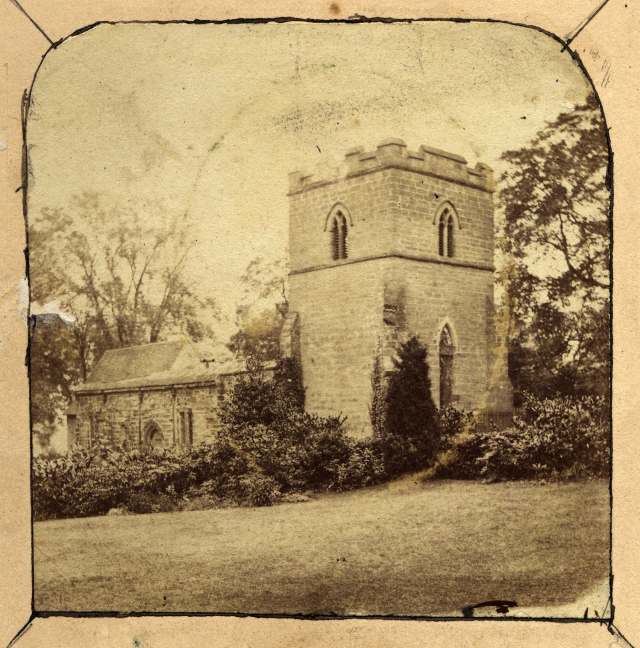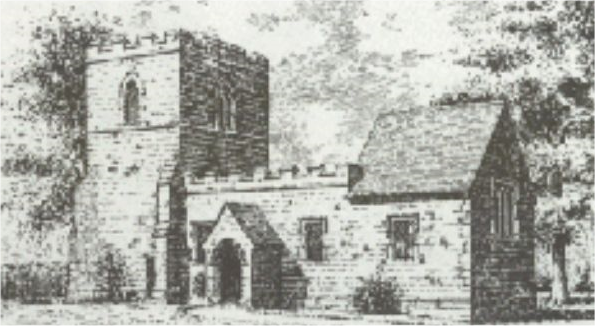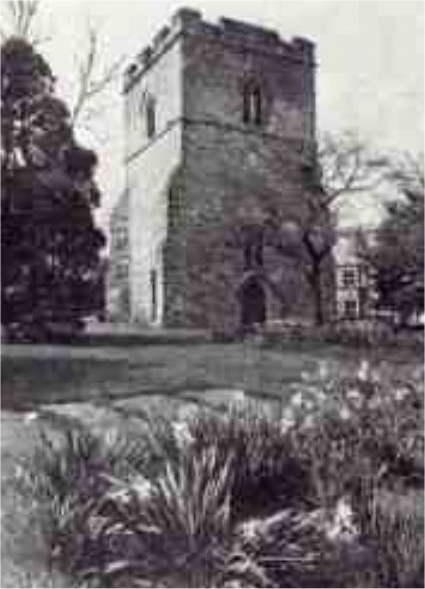At the top of Town Street on a steep little hill opposite the end of Cow Lane stands an old church tower tucked well into a knot of trees. It is all that remains of the former village church.
The earliest days are obscure, but it appears that Christianity came late to this part of England. When eventually the pagan Saxon kingdoms of the Midlands were converted, the boundaries between the Dioceses of the Christian Bishops were uncertain, but it seems that the area now covered by our parish was first in the diocese of Litchfield, possibly for a short while in Leicester or Stow (near Lincoln), and after the Norman conquest, in York. There it remained until it passed into the diocese of Lincoln in 1837. When the Diocese of Southwell was created in 1884, Bramcote was included in it and has been so ever since.
Precisely when the church was first built is also not clear. Sometimes the very early Christian churches sprang up on sites previously associated with heathen worship. There is an attractive legend that the Druids ‘built’ the nearby Hemlock Stone and enacted their rites upon it and that when Christianity came to Mercia the priests took over, as it were, a going concern. There is little to support this belief. The Hemlock Stone is a feature of natural erosion although a very odd one; it is certainly not artificial. Secondly, although Christians might well have adopted pre-Christian sites and customs for their own use elsewhere, there is no evidence that this occurred in Bramcote.
It is likely that in Saxon times the hilltops fringing the valley of the River Trent were more attractive for settlement than the valley below, and Bramcote was no exception. The very name is a Saxon name, ‘cote’ signifying a dwelling-place or habitation. Where there was settlement there would probably be some form of worship also, although this does not necessarily mean the existence of a church. Itinerant priests would visit the villages and say Mass in the fields. (The Saxon cross at Stapleford, for instance, dates from the eighth century and might well have been used as a ‘preaching cross’ before the church was built there).
There is an indirect reference to a chapel in Bramcote in 1246. (The word ‘chapel’ is used here to mean ‘a small church’). At that time the monks at Lenton Priory were engaged in a dispute with Lord de Grey at Codnor “… concerning the right of patronage of the church at Adinboro”. This dispute went on for some time, and at length the Archbishop of York was called in to settle it. The monks must have been a troublesome lot for the Archbishop’s arbitration read: “To make peace and to avoid the effusion of blood”, the monks were induced to accept 40/- (£2) yearly from the chapel at Bramcote.

From the old tower an attempt can be made to estimate the age of Saint Luke’s church. The square massive tower with its embattled roof, angled buttresses, and walls four feet thick belongs to the 14th century. On the other hand the pointed belfry-lights of the tower and the arch of the south door suggest a 13th century origin, and this is supported by the 13th century font (now in the ‘new’ church) which is known to have come from the old church. The most likely explanation is that the church was incomplete when it was first built, and portions were added to it from time to time during later periods. If the building was begin in the 13th century and continued into the 14th, the transition from one style to another in the same building would not be at all unusual.
The Parish Registers
The Bramcote registers were began in 1562 and continue up to the present day. In them one can see the thread of continuity running through the generations of Bramcote folk. For example, the burial of a Richard Starbucke is recorded on 24th November 1650. Three hundred years later the name appears again on the war memorial at the back of the church near to the font.
Consternation in Bramcote
Sixty Seven years after the ‘new’ church was built, it was discovered that no application had ever been made to the Ecclesiastical Commissioners in respect of the new church, and no instrument had been published by them declaring the new church to be a substitute for the old. Apparently these things were necessary when changing from an old church to a new one and their absence created a very awkward situation. For it meant that although the church had been consecrated, the building was not regarded as a place where marriages might properly take place. Naturally, this caused some consternation in Bramcote and steps were very quickly taken to put the matter right. The first step was an application on the 5th of February 1928, to the Ecclesiastical Commissioners signed by the Bishop, all three patrons, and the Vicar, rather belatedly seeking the substitution of the new church for the old. The Ecclesiastical Commissioners responded without delay with an instrument dated 23rd February 1928 making the necessary declaration. This removed the awkward irregularity but it was small comfort for those who had been married in the church before that time. To set their minds at rest, the then Home Secretary – W. Joynson-Hicks – published a Marriage Validity Order on the 5th of February 1929, saying:
“Whereas a new Church of Saint Michael and All Angels in the chapelry of Bramcote was consecrated for divine service on the 12th of December 1861, but it appears that the instrument substituting the said church for the ancient church was not executed until the 23rd of February, 1928. And whereas divers marriages have nevertheless been solemnized in the said church between the 12th of December 1861, and the 23rd of February 1928. And whereas it is expedient in the circumstances to remove all doubt touching the validity of these marriages. Now, therefore, I hereby order that all banns and marriages published and solemnized in the church of Saint Michael and All Angels shall be deemed to have been as valid as if they had been published and solemnized in a church lawfully.”
Finally a special Act of Parliament was published, on the 10th of May 1929, confirming the Home Secretary’s orders, and peace reigned once more in Bramcote.
Conservation in Bramcote
Members of Bramcote Conservation Society and Bramcote History Group have been working extremely hard since 2004 to restore and repair the Grade II listed building, and in 2011 responsibility for the Old Church Tower was finally passed to a specially formed charitable trust ‘Bramcote Old Church Tower Trust’.
Thus far, there have been significant improvements to both the grounds and the building; including a major archaeological survey, restoration to a number of tombs, the placement of seating around the site, installation of new stained glass windows, and suitable access for a number of bats.
The Trust has already won a number of awards for the work they have undertaken, and organises a broad range of activities throughout the year to inform, educate and entertain both the local community and further afield.
For further details of their work, and for information about their open days and various social activities, go to their very informative website:



You must be logged in to post a comment.